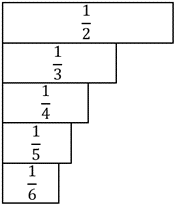Purpose
The purpose of this activity is to support students in equally partitioning a whole length into a given number of parts. Students learn to meet the three criteria for partitioning a whole:
- parts are equal in size
- the correct number of parts are formed
- the one whole (the strip) is completely used (exhausted).
Achievement Objectives
NA2-1: Use simple additive strategies with whole numbers and fractions.
NA2-5: Know simple fractions in everyday use.
Required Resource Materials
- Strips of paper
- Scissors
- Copymaster
Activity
- In this lesson we will fold strips of paper to make fractions, equal parts.
Give each student several strips of the same length (A4 photocopying paper cut lengthwise is good)
Follow these steps. Fold the strip in half. Now fold it in half again but don’t open it.
How many parts have you made? How do you know?
Are the parts equal? How do you know?
Did you use all the strip, the whole?
Students should recognise that they created quarters, four equal parts, before opening the strip to check.
- Ask students to label the parts with the correct symbol, ¼. Cut along the folds to create one quarter length strips. If appropriate to the needs of your students, you could introduce te reo Māori kupu for quarter (hauwhā).
Discuss how the denominator (tauraro) matches the creation of equal parts. (Four parts – 4 as the denominator).
- Take another strip and halve it three times.
Look for students to predict that there are eight equal parts.
What are the parts called? (Eighths - hauwaru).
Label each part with the correct symbol and cut along the fold lines to create one eighth length strips. Connect the number of parts with the denominator 8 in the fraction symbol.
- Explore other sequences of folds. Ask students to find a way to fold a strip into thirds (hautoru), meaning three equal parts. Looping is the easiest strategy to find fifths.

- Investigate these sequences of folds to different fraction length strips:
- Fold the strip in to two equal parts, then fold the halves into three equal parts to get sixths.
- Fold the strip into three equal parts, then fold the thirds in half. Why do students get the same number of equal parts as they do when they folded the strip into halves, and then folded the halves into three equal parts?
- Halve then fifth to produce tenths
- Third then third to produce ninths
- Halve then fifth to produce tenths
- Order the unit fractions by length to reinforce the idea that more partitions produce smaller equal parts.

- Introduce the Copymaster. In these tasks the student must locate the places of equal partitioning without the support of folding. They then transfer the idea to locating given unit fractions when the length of one varies. Provide time for students to work in appropriate groupings that encourage scaffolding and extension, and time for students to share their thinking with a range of students.
Look closely at how your students equally partition the length between zero and one.
Next steps
- Ask students to draw number lines and locate non-unit fractions with the same denominators. For example, they might construct a number line for iterations of one seventh.

Encourage students to make generalisations about the meaning of the numerator as a count of equal parts. They might write equations like, 4/7 = 1/7 + 1/7 + 1/7 + 1/7.
Attachments
finding-unit-fractions.pdf94.59 KB
Add to plan
Level Two